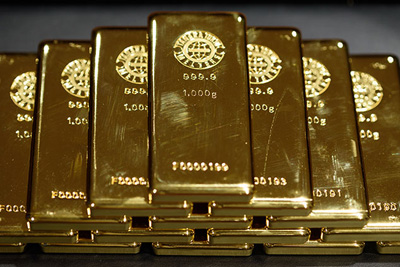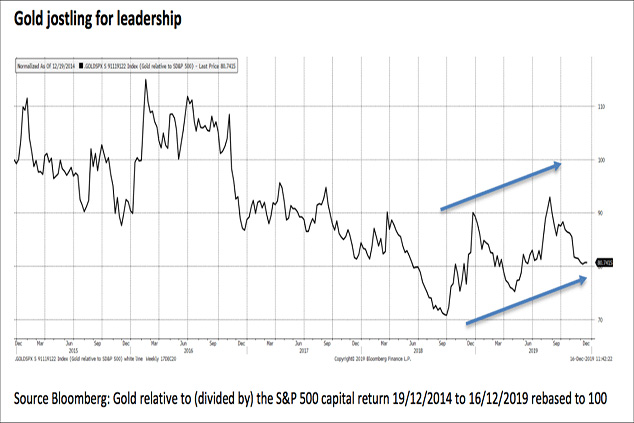Gold’s New Bull Market and Why Over $7,000 Per Ounce Is “Logical” (Part I)
Charlie Morris
 A year ago, in my occasional free newsletter, Atlas Pulse, I upgraded gold – which was trading at $1,239 an ounce at that point – to “bull market” status for the first time since 2012. A year ago, in my occasional free newsletter, Atlas Pulse, I upgraded gold – which was trading at $1,239 an ounce at that point – to “bull market” status for the first time since 2012.
Unlike the gold bugs, I’m not a broken record. And unlike the barbarous relic brigade, I recognise gold’s importance in the modern world.
I analyse the gold price and outline the bull/bear regime with the reasons why. It is an evidence-based approach with an enviable track record. I tell it how I see it and find the air-punching narratives tedious. You won’t find one here.
As I write, the gold price is $1,475 (December 2019), up 15% this year having touched $1,550 (+21%) in September 2019. If the current price holds, this will turn out to be the best year for gold since 2010.
And as we move into 2020, I bring further good news; this bull market has legs.
In fact, a bullish target of $7,166 is logical and plausible.
I’ll get on to how that could happen in Monday’s Money Morning. But for now, let’s start with the basics…
Here’s what a gold bull market looks like
An Atlas Pulse bull market in gold has three conditions that I came up with more than a decade ago:
1. Easy money (US cash real interest rates below 1.8%)
In 2019, the Federal Reserve stood back from further rate hikes, and we’ve seen an increase in the balance sheet, as tapering has reversed course. “It’s not QE,” they say – but it doesn’t smell quite right regardless. Whatever it is, the Fed’s balance sheet is growing again and policy is easy.
2. The long-term gold trend in non-dollar terms must be positive
This simple test ensures we don’t mistake dollar bear markets for gold bull markets. Since 2000, the world’s best currencies have been the Swiss franc and the Thai baht, and gold recently broke higher in both. That implies that gold is rising everywhere.
3. Gold must be beating the stockmarket
Few seem to recall that gold is still the best-performing mainstream asset of the 21st century. It has smashed global equities, which have been held back by poor performance in Europe and Japan. Gold has also managed to stay ahead of US equities, which have been strong since 2013.
Gold even managed to keep up with the emerging markets – they remain the leading equity region to this day, if only just. Gold remains in the lead despite a savage bear market between 2011 and 2016 and having no yield to fall back on. It’s a remarkable achievement, that most people probably don’t realise.
But we want to look forward, not back. You can’t escape that equities nudged past after the 2011 peak. The relative position is important, because investors need to know that they can allocate large sums of money to gold without missing out on equity performance.
If equities are lacklustre or troubled, it’s an easy decision to make. But if they are strong, like they are now, it’s harder.
I can’t promise that US equities will face imminent collapse, but for gold to rally, they don’t need to. The largesse in equities has, in part, come from economic growth, but bigger drivers have been easy money, financial engineering and stimulus.
As we step into 2020, with the threat of tightening behind us, there is no reason for gold to lag equities in future. A Goldilocks scenario (just the right amount of inflation) seems to be unlikely, because we’ve already had that. And since late 2018, asset returns seem to have broadened out. It’s no longer just about US equities.
Can gold start to pull ahead of US equities again as 2020 beckons?
The chart below shows gold versus US equities over the past five years. Gold (reading of 80), means it has only lagged by 20% in a roaring equity bull market dating back five years, which isn’t very much at all.

And since September 2018, gold has been beating equities, with higher highs and higher lows. A new high above 92 would generate significant confidence in the gold market, as that would bank four years of outperformance. It really wouldn’t take much for that to happen.
In short, the Atlas Pulse conditions for a gold bull market are met. I said that this time last year, and I am reiterating that point now. Equity outperformance could be a little stronger, but at least there’s no material lag.
I’ll turn to the one thing that could change everything (part II tomorrow).
This has the power to turn a dreary bull market, driven by falling bond yields, into something you can really sink your teeth into.

Charlie Morris spent 17 years at HSBC Global Asset Management as the Head of Absolute Return managing a multi-asset fund range overseeing $3bn. He is now the CEO and founder of CCData.CC, an analytics platform for blockchains, and edits the Fleet Street Letter, a financial newsletter.
moneyweek.com
| 



